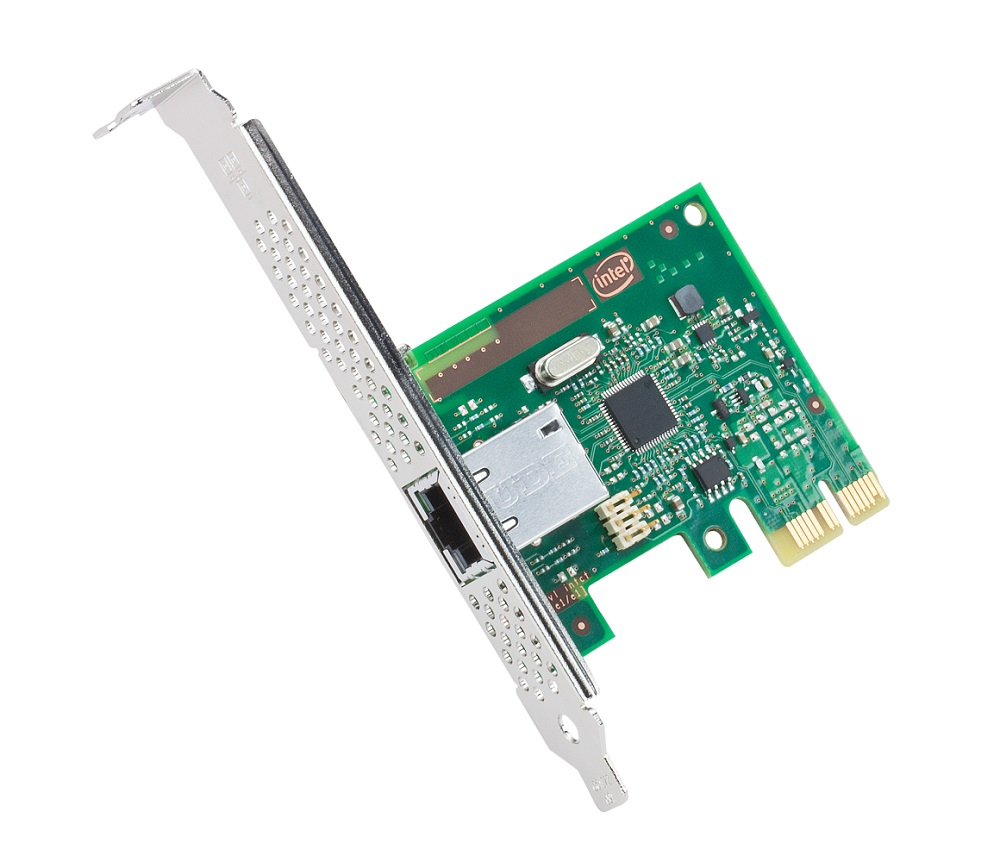

P/N:I210T1BLK | EAN:8592978112264 | CHECKSUM: T
Warranty: 1 year
Excl VAT. € 41.56
€ 50.29
In stock: 136 ETA: 0000-00-00Weight: -
The new Intel® Ethernet Server Adapter I210 builds on Intel’s history of excellence in Ethernet products. Intel continues its market leadership with this newest generation PCIe* GbE network adapter. Based on the Intel® Ethernet Controller I210, this adapter represents the next step in the Gigabit Ethernet (GbE) networking evolution for the enterprise and data center offering Audio-Video-Bridging (AVB) support, along with power management technologies such as Energy Efficient Ethernet (EEE) and DMA Coalescing (DMAC).
Audio-Video Bridging (AVB)
The Intel® Ethernet Server Adapter I210 supports IEEE 802.1Qav Audio-Video Bridging (AVB) for customers requiring tightly controlled media stream synchronization, buffering, and reservation. The 802.1Qav is part of the AVB specification that provides a way to guarantee bounded latency and latency variation for time sensitive traffic and includes:
- Timing and Synchronization for timespecific applications (802.1AS) Stream Reservation (SR) protocol to guarantee the resources needed for Audio/Video (AV) streams (802.1Qat)
- Forwarding and queueing enhancements for time sensitive streams (802.1Qav).
Performance Optimization
The Intel® Ethernet Server Adapter I210 contains four transmit and four receive
queues. These queues offer Error Correcting Memory (ECC) protection for improved data reliability. The adapter efficiently manages packets with minimum latency by combining parallel and pipelined logic architectures optimized for these independent transmit and receive queues. These queues, combined with Receive Side Scaling (RSS) and Message Signal Interrupt Extension (MSI-X) support, optimize the performance on servers with multi-core processors.
Power Management Technologies
Today, companies everywhere are looking for ways to decrease energy consumption across the enterprise to reduce costs and environmental impact, while at the same time solving increasingly important power density challenges. That’s why Intel has introduced new, advanced Power Management Technologies (PMTs that enable enterprises to configure power options on the adapter and more effectively manage power consumption.
Energy Efficient Ethernet (EEE)
The Intel Ethernet Server Adapter I210 family supports the IEEE802.3az Energy Efficient Ethernet (EEE) standard so that, during periods of low network activity, EEE reduces the power consumption of an Ethernet connection by negotiating with a compliant EEE switch port to transition to a low power idle (LPI) state. This reduces the controller power to approximately
50% of its normal operating power, saving power on the network port and the switch port. When increased network traffic is detected, the controller and the switch quickly come back to full power to handle the increased network traffic. EEE is supported for both 1000BASE-T and 100BASE-TX.
DMA Coalescing
Another power management technology that can reduce power on the server platform is DMA Coalescing (DMAC). Typically, when a packet arrives at the adapter, a DMA request is initiated in order to place the packet into host (or server) memory. This transaction wakes up the processor, memory, and other system components from a lower power state in order to perform the tasks required to handle the incoming packet. Based on the configurable DMAC settings, incoming packets are buffered momentarily before any DMA calls are made. This enables the controller to intelligently identify opportunities to batch multiple packets together so that when components are wakened from lower power states they can efficiently handle the
batched packets at the same time. This enables platform components to remain in lower power states longer, which can dramatically reduce platform energy consumption. DMAC synchronizes DMA calls across all controller ports to ensure maximum power savings.
Environmentally Friendly Design
The Intel® Ethernet Server Adapter I210 Family is low halogen1 and completely lead-free to reduce the pote
| Logistics data |
| Harmonized System (HS) code: 85176990 |
| Network |
| Cabling technology: 10/100/1000BaseT(X) |
| Ethernet LAN: Y |
| Ethernet LAN data rates: 10,100,1000 Mbit/s |
| LAN controller: Intel I210 |
| Maximum data transfer rate: 1000 Mbit/s |
| Maximum operating distance: 100 m |
| Networking standards: IEEE 802.3, IEEE 802.3ab, IEEE 802.3u |
| Other features |
| Bracket height: Low-Profile (LP) / Full-Height (FH) |
| Cable type: RJ45 Category 5, up to 100 m |
| Cabling type: RJ45 Category 5, up to 100 m |
| Commodity Classification Automated Tracking System (CCATS): NA |
| Conflict-Free: Y |
| Controller type: Intel I210 |
| Ethernet adapter ARK ID: 68668 |
| Export Control Classification Number (ECCN): 5A991 |
| Fiber Channel over Ethernet: N |
| Intel Data Direct I/O Technology: N |
| Intel Ethernet Power Management: Y |
| Intel Flexible Port Partitioning: N |
| Intel Virtual Machine Device Queues (VMDq): N |
| Intelligent Offloads: Y |
| Interface type: PCIe v2.1 (2.5 GT/s) |
| iWARP/RDMA: N |
| Last change: 63903513 |
| Launch date: Q1'13 |
| Low halogen options available: N |
| Market segment: Server |
| Network interface card cable medium: Copper |
| Network interface card type: Server |
| On-chip QoS and Traffic Management: N |
| PCI-SIG* SR-IOV Capable: N |
| Processor family: Gigabit Ethernet Adapters (up to 2.5GbE)-Gigabit Ethernet Adapters (up to 2.5GbE) |
| Product brief URL: http://www.intel.com/content/www/us/en/network-adapters/gigabit-network-adapters/ethernet-server-adapter-i210-brief.html |
| Product family: Intel Gigabit server adapter |
| Product series: Intel I210 |
| Product type: Network Interface Card |
| Speed & slot width: 2.5 GT/s, x1 Lane |
| Status: Launched |
| Thermal Design Power (TDP): 1 W |
| Thermal power: 1 W |
| Ports & interfaces |
| Connectivity technology: Wired |
| Ethernet LAN (RJ-45) ports: 1 |
| Host interface: PCI Express |
| Interface: Ethernet |
| PCI version: 2.1 |